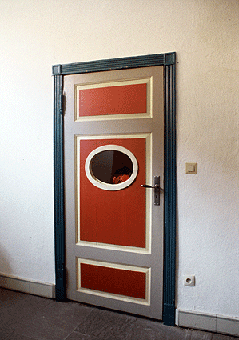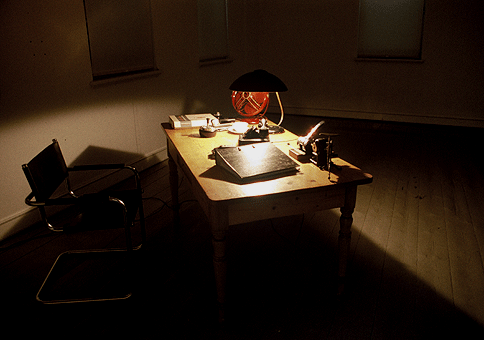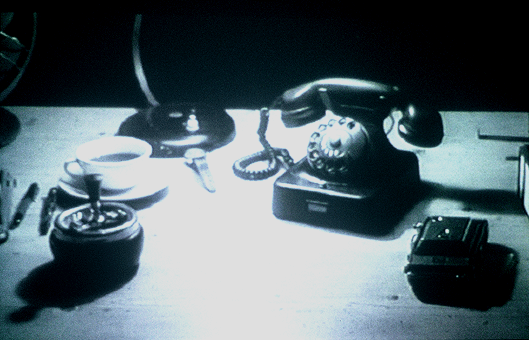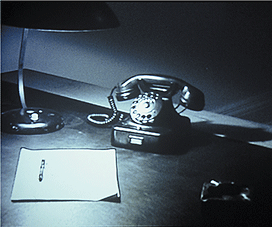Give me a BREAK
Considerations regarding a "ready to film" Installation by Alexander Steig
Visual arts and (mainstream) film reference each other again and again in the contemporary discourse. With good reason: exciting problems such as the correlation of perspective and representation, desire and control, as well as static and moving pictures are of central elements in both aesthetic systems. This also applies to the works of Alexander Steig, especially his duo-room (video)installation BREAK. First, some references to the world of film.Couples love to remember: the movie "Lost Highway" by cult-director David Lynch, starring beautiful Patricia Arquette. Someone unknown regularly observes a married couple in their own apartment; each morning the naturally anxious couple receives the results of the observation on videotape, unsolicited, just left in front of the house. Suddenly one of these tapes shows a future murder, visually moved forwards on tape.
A more recent example from contemporary film history: "Panic Room" by David Fincher, this time starring the incredible Jodie Foster. From a secure room, like the title says the "Panic Room", a mother and daughter observe - threatened by three burglars - these burglars as they move all over the house. Then all of a sudden the observation room becomes an instrument in the hands of the supposedly locked-out criminals.
The relationship between video-technique and space appears in the movies again and again. Some more examples of video- and observation-focused films: "Sex, Lies and Videotape" by Steven Soderberg, "American Beauty" by Sam Mendes and, last but not least "The Blair Witch Project" by Daniel Myrick. The amassing of such films is no coincidence: the dialectic of locked in and locked out, of in- and outside, as well as real time and playback with the relation of video and space leads to the point. Moreover, these three dialectics are fundamental for the perception of film in general.
Two quick related points:
A. Frenchman Gilles Deleuze emphasizes in his film theory that there are always two sides to the perception of film, because this perception would be a study of the eye, which on the one hand includes perception of visual perception, the seeing of the seen. On the other hand, the cinematic receipt, always the "reverse - imagination, mind or knowledge" - comes to light1.
It is exactly this duplicity of the receptive events that prevents a quasi uncertain identification, but nicely allows a reflective insertion of the self. This leads to the consequence that you are always inside and outside at the same time at the movies. Who actually has Brigitte Bardot in bed in the wonderful movie "Viva Maria" from Louis Malle.
B. In her important essay, "Visual Pleasure and Narrative Cinema", the feminist film theorist Laura Mulvey handles exactly this point of seen subject and filmed object of desire. For Laura Mulvey it is of great importance that there are quasi three views at the movies,1. the camera's view, which creates the illusion of a renaissance-room,
2. the audience's view towards the people acting in front of the camera; and
3. the views of the acting artists among one another, which brings desire to the viewer, but does not give him the possibility to interact.In short: The effect of Laura Mulvey's developed trisection is the erasure of the concrete room to the benefit of a thrilling-psychological happening2.
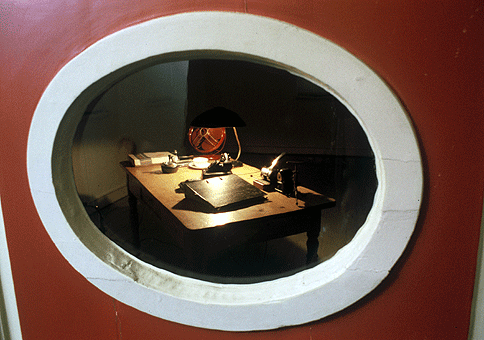
break, 2001, Künstlerstätte Heiligenrohde, Community of StuhrBut what does all this have to do with Alexander Steig's work BREAK? The answer becomes apparent by taking a closer look: There are two rooms, one is accessible, the other is not. The inaccessible room, which is only visible through the door, is being filmed in real-time with a stationary camera. Inside there is a film noir scenario, with chair and table among other things. On top of the table are an ashtray, fan and a phone, which - bringing to mind Sergio Leones "Once upon a time in America" - rings from time to time, calling for interaction, for picking up the phone. Alfred Hitchcock, the master of suspense, also rings a bell.
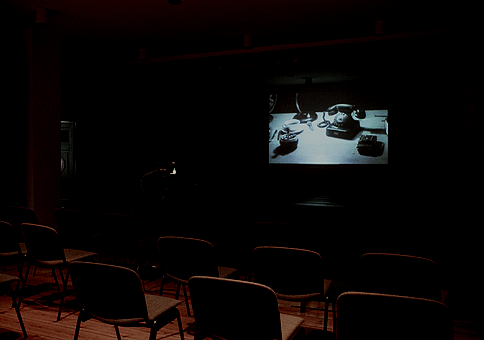
break, 2001, Künstlerstätte Heiligenrohde, Community of StuhrIn the second room, the accessible one, welcoming rows of chairs are standing and the scenario from the first room is projected on the wall in real-time. One is in the room at the same time, at least in the imagination, in another one. The American artist Robert Smithson called it "Non-Site"; the French philosopher Michel Foucault "Heterotopy". In any case different modalities of inside and outside, of activity and passivity, of identification and defence penetrate this un-located installation.
By the way, all three moments, therefore all three glances, that Laura Mulvey describes, as mentioned above, appear in the work BREAK.
1.the camera's view, which creates the illusion of a renaissance-room
2.the audience's view of the scenario in front of the camera
3.the views of the acting artists towards one another however, those which create mood in the viewer, but do not allow him to interact, here simply occur by the ringing phone


break #4, 2004, ART GENE, Barrow-in-Furness, GB
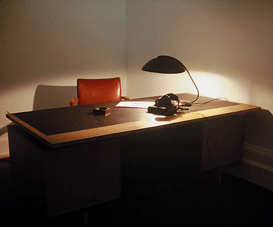
break #3, 2003, Arteppes - Espace d'Art Contemporain, Annecy, F ..... ... .................................................................................................Apropos renaissance-room: Alexander Steig willingly created an "unmotioned" picture in BREAK, much like a still shot. This way the artist manages to stretch the questions of identifying view and interacting viewer onto the genre of painting, even representation in general. Here one likens back to the legendary painting "The Maids of Honour" of Velasquez, in the interpretation of Michel Foucault: The seeing of seeing and the make ability of the visible The Frenchman writes in his "The Order of Things" in 1966: "This painting of Velasquez may certainly contain the representation of the classic representation and the definition of space, which it opens. It surely does undertake to represent itself in all the elements, with its pictures, its views, which it offers itself, the faces, which it makes visible, the gestures, which the representation evokes….."3.
Raimar Stange
Translation: Daniel Hautmann, Hamburg
1 Gilles Deleuze, Time Machine, Frankfurt a. M. 1997
2 Laura Mulvey, Visual Pleasure and Narrative Cinema, in: Texte zur Theorie des Films, Stuttgart 1988, S. 389 ff.
3 Michel Foucault, The Order of Things, Frankfurt a. M. 1974, S. 45(Katalog break, Foro Artistico, International Media-Art Forum, Hannover, 2007)
